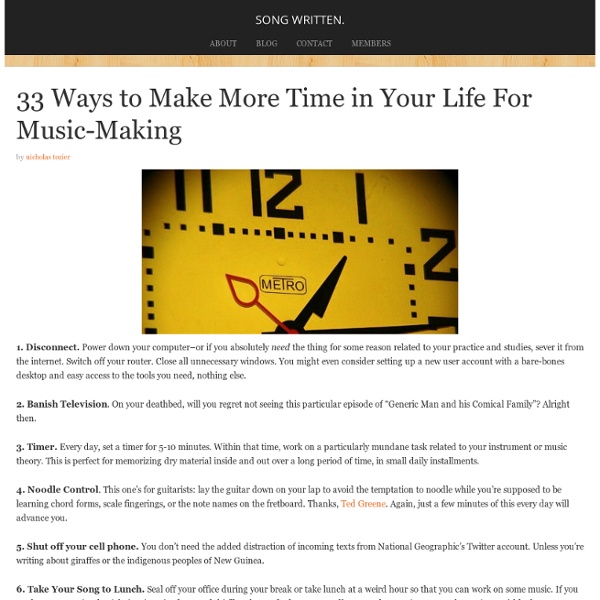



47 Sites Every Recording Musician Should Visit - StumbleUpon In a recent “Open Mic” we asked you, “Which music-related sites do you visit regularly?” This article is a summary of the great suggestions given in the comments to that article. You can make the list even longer by commenting on this article. As you’re reading this article, Audiotuts+ needs no introduction. This is a great Flash site with many resources to help you learn music theory. The site content is split up as follows: Lessons, including topics that cover notation, chords and scalesTrainers, that teach you notes, keys, intervals, triads, keyboard, guitar and brass. Michael comments: “I have found very helpful. This is a site that helps you with scales and chords. The charts are guitar-based, and there are options for various alternate tunings and other stringed instruments. A website that helps you learn musical scales and chords. Subtitled “Learn music technology”, this site is all about learning audio. Joe comments: “Great Ableton/sound design videos.”
Relative key Circle of fifths showing major and minor keys Relative tonic chords on C and A ( Play ). Chromatic modulation in Bach's Du grosser Schmerzensmann, BWV 300, m. 5-6 ( Play with half cadence, Play with PAC) transitions from FM to its relative minor dm through the inflection of C♮ to C♯ between the second and third chords. The minor key starts three semitones below its relative major; for example, A minor is three semitones below its relative, C Major. G major and E minor both have a single sharp in their key signature at F♯; therefore, E minor is the relative minor of G major, and conversely G major is the relative major of E minor. A complete list of relative minor/major pairs in order of the circle of fifths is: See also[edit] References[edit]
How to strengthen your willpower 7 April 2012Last updated at 20:47 ET By Stephanie Hegarty BBC World Service Willpower is sorely tested at Easter, when temptation comes in abundance and is often coated in chocolate. But a new book suggests that people who exercise greater self-control are those who have greater success in life. Roy Baumeister seems to cut a good example of self-regulation. The psychologist is sharply dressed, immaculately groomed and his calm, well-punctuated speech betrays a quiet confidence. "You might think that people with really strong self-control struggle through this grim existence, forcing themselves constantly to do the right thing," he says. "But that's not correct. In his book Willpower: Rediscovering our Greatest Strength, co-written by journalist John Tierney, he claims that willpower - the ability to control impulses and thoughts, and persevere with tasks - is a limited resource which is depleted every time we successfully resist temptation. He believes willpower is a physiological resource.
Harmony Explained: Progress Towards A Scientific Theory of Music The Major Scale, The Standard Chord Dictionary, and The Difference of Feeling Between The Major and Minor Triads Explained from the First Principles of Physics and Computation; The Theory of Helmholtz Shown To Be Incomplete and The Theory of Terhardt and Some Others Considered Daniel Shawcross Wilkerson Begun 23 September 2006; this version 19 February 2012. Abstract and Introduction Most music theory books are like medieval medical textbooks: they contain unjustified superstition, non-reasoning, and funny symbols glorified by Latin phrases. In particular we derive from first principles of Physics and Computation the following three fundamental phenomena of music: the Major Scale, the Standard Chord Dictionary, and the difference in feeling between the Major and Minor Triads. Table of Contents 1 The Problem of Music1.1 Modern "Music Theory" Reads Like a Medieval Medical Textbook 1.2 What is a Satisfactory, Scientific Theory? ... wbwbw wbwbwbw wbwbw wbwbwbw ... What is a "scale"? Really?!
Six Keys to Being Excellent at Anything I've been playing tennis for nearly five decades. I love the game and I hit the ball well, but I'm far from the player I wish I were. I've been thinking about this a lot the past couple of weeks, because I've taken the opportunity, for the first time in many years, to play tennis nearly every day. My game has gotten progressively stronger. I've had a number of rapturous moments during which I've played like the player I long to be. And almost certainly could be, even though I'm 58 years old. During the past year, I've read no fewer than five books--and a raft of scientific research--which powerfully challenge that assumption (see below for a list). We've found, in our work with executives at dozens of organizations, that it's possible to build any given skill or capacity in the same systematic way we do a muscle: push past your comfort zone, and then rest. There is something wonderfully empowering about this. Pursue what you love. Here are the recent books on this subject:
Music Text Composition Generator ( A free online music utility) The P22 Music Text Composition Generator allows any text to be converted into a musical composition. This composition is displayed in musical notation and simultaneously generated as a midi file. 1. Usage Type or copy any text into the Text Field. Give the file a unique name. A short text may be best at a slow pace (IE 10 BPM) whereas a longer text may prove more engaging at 1200 BP. In some browsers (Safari 2 or greater), the ability to play real time multi-tracking can allow for complex compositions. The generated musical text does not claim copyright nor imply any rights from the text used. 2. The P22 Music Composition Font was proposed in 1997 to the John Cage Trust as an accompaniment to the John Cage text font based on the handwriting of the composer. 3. P22 Music Pro is a unique font system that expands on the concept used in the Music Text Composition Generator. The font used in the P22 MTCG is a basic version that closely follows the initial Cage inspired idea. 4.
Live and Work Anywhere | Location Independent